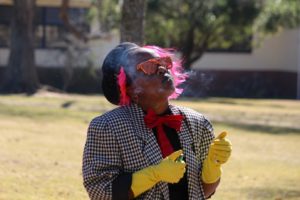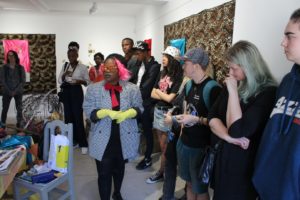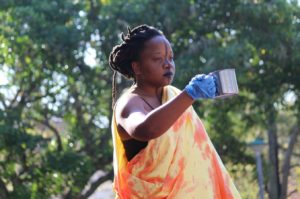
Self-fulfilment is the primary reason I do the work. That is why I insert and immerse myself in the work. Even when I am doing painting or textile work, I find a way of portraying self in the work. Raising awareness of issues is the reason I do live art. I like it because the impact is direct and immediate. I almost force my audience to react instantly.
Barnabas Ticha Muvhuti in conversation with Kresiah Mukwazhi
In Conversation with Kresiah Mukwazhi
Kresiah Mukwazhi is a Harare-based multidisciplinary artist who is a Fellow of the “Arts of Africa and Global Souths” Residencies for Artists and Writers (RAW) programme in the Fine Art Department at Rhodes University in Makhanda, South Africa. During the 2019 National Arts Festival, she performed Summoned from Luzari as part of the Arts Lounge festival programme. Her two-months residency resulted in the Although I am Young, I am the Mother of this House open studio session in which the audience was invited to engage with the artist and the ideas she has been, is and will be working on. The persona Hes Keresiya, which came to life on that day, is one of the ideas. In this conversation, Barnabas Ticha Muvhuti asks Mukwazhi about her work during the residency and her artistic practice in general.
Barnabas Ticha Muvhuti (BTM): Are there particular themes you address in your work, or it is dictated by current socio-political developments, situations and problems?
Kresiah Mukwazhi (KM) Trauma is a recurring theme in my work. My practice is a visual language that I am using to heal myself and others that relate to experiences of violence, exploitation, and abuse. To question and resist patriarchal societal norms and to expose how they have affected our beliefs and what we conform to as a society.


A-persona from Hes Keresiya, from 2014 on
BTM: Tell me more about Hes Keresiya
KM: Hes Keresiya is an ongoing series of self-portraits that was born in 2014. I was at Market Photo Workshop then, in Johannesburg, and we had been assigned to make a body of work of choice. I was really scared to move around Egoli, I did not feel safe, so I turned the camera on myself and became the subject.
BTM: So, sometimes you work with characters that you can pause, and then reactivate?
KM: Absolutely. It is a process, an ongoing journey of finding meaning and understanding.
BTM: You have done work that addresses the #MeToo movement. In the 2019 National Arts Festival in Makhanda, the audience witnessed you personifying Dr. Stella Nyanzi in Summoned from Luzari. How important are trending global issues to your work?
KM: Dr. Stella Nyanzi is being prosecuted for exercising free speech. She is just one example of many others that show how expressions of resistance result in victimization and violence. I’ve been looking at the concept of freedom and safety. Asking myself if I am free as an artist and if my body is safe? This is what I was communicating in ‘Summoned from Luzari’.
BTM: Do you always research before performing or making work? Or simply turn to your experiences? How important is that?
KM: The base of my research is usually nostalgic experience. From the Zimbabwean drama series that featured on national television when I was a child, to my mother’s tapestries and the way she would adorn the furniture in our home. I borrowed the persona of my performance yesterday from Mbuya vaSorobhi, a woman characterized as a cross-border trader, who smokes cigarettes and enjoys spending her free time in bars. Her best friend is a sex worker and is characterized as a free-spirited woman who wears lipstick and fashionable clothing. Interestingly, these were not the characters that one would be encouraged to learn from. Rather the more focused on characters were the ones who were married and had husbands (the main actors) that were constantly having extra-marital affairs or disrespecting them in one way or another. I was thinking about all these representations and how I could use them as a visual language to understand myself and to empower female bodies.
Sometimes my research is through interactions with people, spending time in their homes and letting them tell their own stories. I first met sex workers at Hopley Farm when I was assigned to document a project in which they were participants. The project was supported by Katswe Sisterhood, a movement that supports vulnerable women. So, over a period I developed a relationship with them until I was comfortable to share my interest and informed them of my need to involve them in the work I do. They welcomed me into their homes. They embraced my art. In that case, I did not need to open a book to understand what it is like to be a sex worker.


Summoned from Luzari, 2019. Live-Art.
BTM: A friend always tells me that if you listen to Zimbabweans regurgitating Bible verses, you would think they witnessed the process of writing the ‘holy’ book. In university, I witnessed male students catcalling female students wearing short dresses. Women are afraid to wear short dresses in townships like Mbare. The point I am trying to make is ours is a judgmental and conservative society. And yet you use women’s undergarments in your work. How has the reception of the work in Zimbabwe been like?
KM: I believe that one of the ways to address something so crude as the violation of female bodies is through pushing boundaries. So, I play with discomfort in my work in a way to provoke emotion and reaction. There was one person who refused to participate in my performance yesterday. That resistance means something, it performs something. He asked me if my work was directed at someone and I said well if the cap fits… And that is the work. Another said the work was spicy. It is all these things, it has an aura, taste, smell, and feeling. My first experience of how my work evoked smell was at Villageunhu, and then at the ICA Live Art workshop. I burnt my hair and the smell performed a sense of discomfort as well. I like these reactions because what I express in my work does not come from a place of comfort at all. It’s not palatable so to speak.
BTM: Does it mean there is a tendency to read the work literally and ignore the conceptual aspect of it?
KM: Generally, in an art space, there is an appreciation of the conceptual side of the work. But for someone who is not an artist, it is a different story altogether. For example, when my studio was at my parents’ house, I could see the confusion. There was a lack of trust in what I was trying to do. That at that time I did not have the vocabulary to explain the work did not help either.
BTM: Your work is about social reality? Is the goal raising awareness and consciousness for the audience or self-fulfilment for the artist?
KM: Self-fulfilment is the primary reason I do the work. That is why I insert and immerse myself in the work. Even when I am doing painting or textile work, I find a way of portraying self in the work. Raising awareness of issues is the reason I do live art. I like it because the impact is direct and immediate. I almost force my audience to react instantly.

BTM: I remember when you put out a call for bras around Rhodes University, you found some of the boxes shifted from the strategic spots you had placed them. When you went to source hair at the salons people were a bit uncomfortable giving it to you. Tell me more about the politics of collecting hair and bras for your practice.
KM: The politics is that there will be people who may associate my material with black magic, madness or mental illness. I don’t care much about that. My language is visual, and material is fluid.
BTM: Do you always collect used bras? Would it not be easier to buy and exchange a new one for the old? I think the Ghanaian artist Ibrahim Mahama does the same with hessian bags. Or bras are too personal for that?
KM: He uses new ones as well, just that he puts them together in such a way that one cannot tell the difference. I’m open to trying it though. I’ve used both, but I mostly prefer the used ones. I might use new ones in the case of an emergency haha! I buy the used ones from second-hand clothing bales and street boutiques.
BTM: You switch from photography, sculpture, painting, to live art, or at times integrate them. Is it not difficult to switch from one medium to the other?
KM: It is difficult, but also interesting. I like to think of myself as an octopus and the media that I work with being like my hands. Each hand or limb has own mind. When it comes to photography, for example, it is a medium through which I can be who I want to be and do what I want to do. It operates on its own. So do my sculpture and textile work. Of course, at some point, all these media can converge. The process is organic. Like now in Although I am young, I am the mother of this house. This is the first time I am seeing my photography work meeting my textile work. It’s a matter of time, space and the process.
BTM: Is there a favourite discipline or medium among those that you work with?
KM: Not really. They just work together.
BTM: Although I am young, I am the mother of this house is born out of a project you started a few years back. Is there always continuity in your work, and do you use certain media to address certain themes?
KM: That is not always the case. In this case, I felt I could draw on my old work because I finally had space which I felt suited it perfectly. The space that I am working from in Harare is clustered with other ideas that were born in between. They are in the state of becoming. I have ideas that I have shelved as I have been constantly on the move. Being in the RAW Spot Gallery and looking at this space I realized this is the time for this body of work to come to life.
BTM: Zimbabwean author Tsitsi Dangarembga posted on Facebook that Zimbabwe needs its #MeToo moment. As a subject you have previously addressed, do you agree with that?
KM: Certainly! I do agree with her. I think we are in it already, just that it is not pronounced or named that. There are communities of women who are coming together, whether as friends or organizations, and they are creating safe spaces to discuss and share the struggles that we are facing every day. We are going through a lot as a nation, men and women, we need to hold space for each other, at times to just cry and find a release. Our struggles intersect.
BTM: One of my favourite authors Arundhati Roy from India says society is obsessed with categorizing artists and writers. One art critic from Namibia recently called you a visual activist. Does it matter?
KM: I would agree with Arundhati Roy because I cannot dictate how people receive or perceive my work. The work speaks for itself. Today you can read about me as something. A year later you might read of me being something else. Those categories are always shifting. I don’t like to be boxed.


Although I am young I am the mother of this house, 2019. Open-Studio
BTM: The Zimbabwe arts scene is dominated by male artists. How easy or difficult was it for you to gain recognition? Are there female artists who mentored you that deserve special mention?
KM: The first female artist I recognise, and honour is my late grandmother, Keresiya Bayisayi Mukwazhi. She was my first inspiration. Then my mother made and mend clothes. She was a Home Economics teacher who taught cooking and sewing. That was her art. I inherited so much from both. Then I would also acknowledge my art teacher at Watershed College, Shwele Mamvuto, she believed in me and nurtured my talent from those early years. As I was doing my research at Watershed, which was my high school, I met Helen Lieros, Georgina Maxim, Portia Zvavahera and Virginia Chihota. Then at the BAT Workshop, I met Doris Kamupira and Mercy Moyo. After that, I met Valerie Kabov who is running the First Floor Gallery. I have learned a lot from Tandazani Dhlakama who was also one of my trainers at the BAT Workshop and is now at the Zeitz MOCAA in Cape Town. Dana Whabira has been very supportive in helping me sharpen and grow my practice. The amazing photographers of Zimbabwe Association of Female Photographers (ZAFP) and the two lovely Michelles now running ‘Through the Lens’. I cannot name them all, but I am grateful to many women who have advised and supported me along the way. I am where I am today because these powerful women paved the way for me.
BTM: You have performed at the Chale Wote Street Art Festival in Ghana, Katutura Community Arts Centre in Namibia, and you did a residency at Nafasi Arts Space in Dar es Salaam, Tanzania. Now you’re in South Africa, not in metropolitan Johannesburg or Cape Town, but Makhanda. How important is taking your practice to these areas?
KM: I am learning a lot from being in these areas. I felt that in terms of discovering my identity and gaining self-fulfilment, Africa is the space that would provide answers to my questions. I just knew I had to be home, and home is Africa before I go anywhere else.
BTM: But you’re open to taking your work beyond the motherland?
KM: At this point, I would admit I am ready to do that. Interestingly, some of my work has beaten me to this. It’s just my performance work that has stayed with me here.
BTM: In the Summoned from Luzari performance, there were lines in the polemic poem that the audience was not comfortable reciting. Someone asked me why you were taking off those panties. Are you an artist who always likes to push boundaries?
KM: I guess the idea of pushing the boundaries comes from an urge to put the message across in the strongest way possible.
BTM: You have touched on issues like #FreeStellaNyanzi, the plight of the Hopley Farm Sex Workers, and so on. What inspires you to tackle these ‘sensitive’ issues?
KM: I am inspired by the greatness of God’s Creation through nature. I am inspired by my grandmother’s pottery skills. I also draw inspiration from all the beautiful things that paint the world as a better place than it is today.
BTM: Does your live art sometimes surprise you?
KM: Yes, it does, hahaha! I remember when I was sketching the persona I performed during my open studio, reflecting on how she has been quiet for a long time, and now she has come to life. I remember asking myself if I was even ready for it. I was internally just as surprised as you were haha 🙂
BTM: When did you decide to become an artist?
KM: I cannot say I decided to become an artist. But I was drawn to art at a very young age by observing my grandmother making clay pots. She had no machinery. She just used bare hands. I was also inspired by my siblings. One of my brothers used to play mbira, another used to act in dramas that would show on national television, and the other one is a very prominent photojournalist. Paying attention to the patterns in my mother’s tapestries and clothes also had a big impact on me. I was always been drawn to those practices in the family, up to a point when I had to find my way. And my practice is multifaceted because I have been influenced by all these different aspects.
